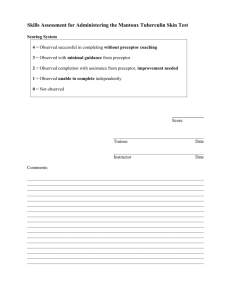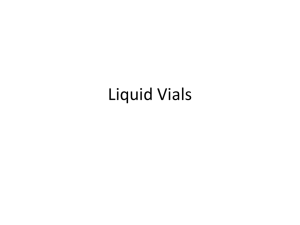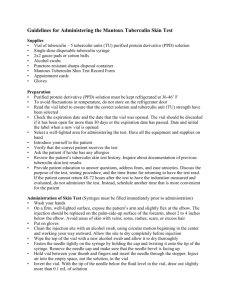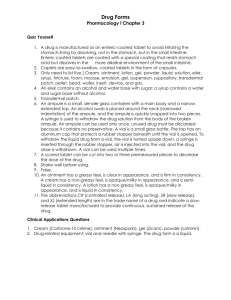Moapar powder and solvent for suspension for injection ENG PL
advertisement
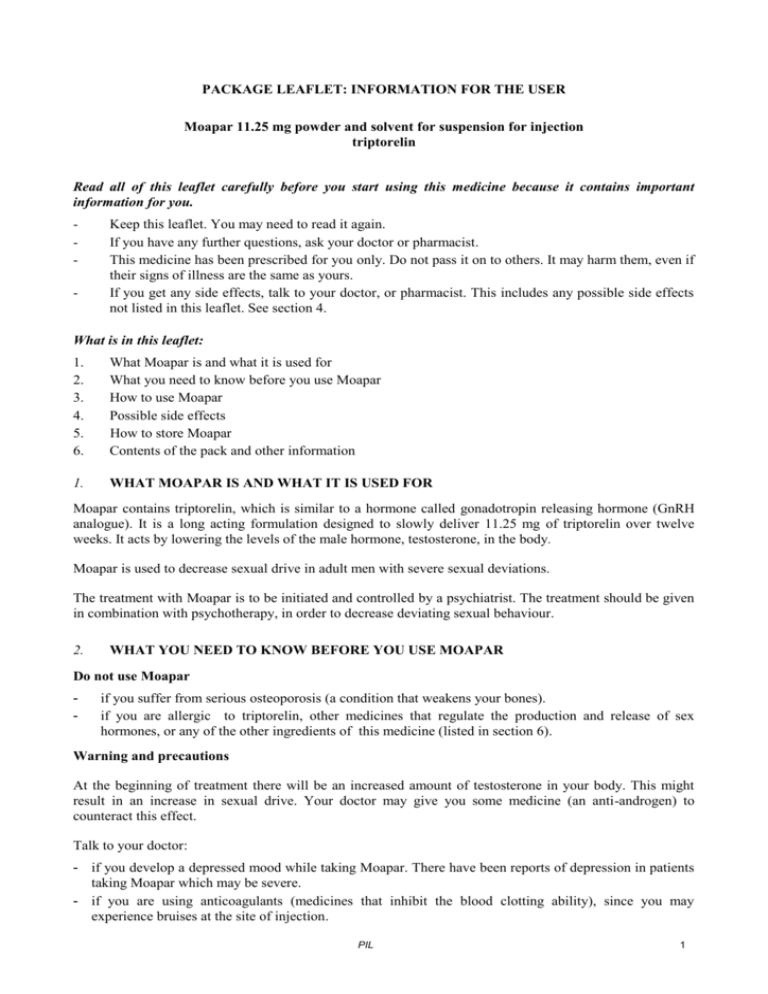
PACKAGE LEAFLET: INFORMATION FOR THE USER Moapar 11.25 mg powder and solvent for suspension for injection triptorelin Read all of this leaflet carefully before you start using this medicine because it contains important information for you. - Keep this leaflet. You may need to read it again. If you have any further questions, ask your doctor or pharmacist. This medicine has been prescribed for you only. Do not pass it on to others. It may harm them, even if their signs of illness are the same as yours. If you get any side effects, talk to your doctor, or pharmacist. This includes any possible side effects not listed in this leaflet. See section 4. What is in this leaflet: 1. 2. 3. 4. 5. 6. What Moapar is and what it is used for What you need to know before you use Moapar How to use Moapar Possible side effects How to store Moapar Contents of the pack and other information 1. WHAT MOAPAR IS AND WHAT IT IS USED FOR Moapar contains triptorelin, which is similar to a hormone called gonadotropin releasing hormone (GnRH analogue). It is a long acting formulation designed to slowly deliver 11.25 mg of triptorelin over twelve weeks. It acts by lowering the levels of the male hormone, testosterone, in the body. Moapar is used to decrease sexual drive in adult men with severe sexual deviations. The treatment with Moapar is to be initiated and controlled by a psychiatrist. The treatment should be given in combination with psychotherapy, in order to decrease deviating sexual behaviour. 2. WHAT YOU NEED TO KNOW BEFORE YOU USE MOAPAR Do not use Moapar - if you suffer from serious osteoporosis (a condition that weakens your bones). if you are allergic to triptorelin, other medicines that regulate the production and release of sex hormones, or any of the other ingredients of this medicine (listed in section 6). Warning and precautions At the beginning of treatment there will be an increased amount of testosterone in your body. This might result in an increase in sexual drive. Your doctor may give you some medicine (an anti-androgen) to counteract this effect. Talk to your doctor: - if you develop a depressed mood while taking Moapar. There have been reports of depression in patients taking Moapar which may be severe. - if you are using anticoagulants (medicines that inhibit the blood clotting ability), since you may experience bruises at the site of injection. PIL 1 - if you are a heavy drinker, a smoker, have osteoporosis (a condition that weakens your bones) or have a family history of osteoporosis, have a poor diet or take anticonvulsants (medicines for epilepsy or fits) or corticosteroids. When Moapar is used for a long period of time the risk of developing weak bones is increased, especially if any of the above applies. In order to prevent brittleness of the bones, a healthy lifestyle including no smoking, moderation of alcohol consumption and regular weight bearing exercises that put a load on and strengthens the skeleton, is recommended ( e.g. walking, jogging, other forms of sports that put a load on the skeleton). Adequate dietary calcium and vitamin D intake should also be maintained. - if you are about to take a diagnostic test of pituitary gonadal function. The result can be misleading if you are on Moapar treatment or after discontinuation of Moapar treatment. - if you experience sudden headache, problems with eye sight and paralysis of the eye muscles. This can be signs of a benign tumour of the pituitary gland which may become evident under treatment with Moapar. - if you have diabetes, or if you suffer from heart or vascular problems. - Any heart or blood vessel conditions, including heart rhythm problems (arrhythmia), or are being treated with medicines for these conditions. The risk of heart rhythm problems may be increased when using Moapar. When the treatment is stopped, testosterone will return to normal levels and your sexual drive may increase again. Therfore, your doctor may give you an other medicine in order to control this effect. Children and adolescents Moapar is not indicated for use in neonates, infants, children and adolescents. Other medicines and Moapar When Moapar is taken with medicines which affect the release of hormones from the pituitary, your doctor may need to do additional checks. Tell your doctor or pharmacist if you are taking, have recently taken or might take any other medicines. Moapar might interfere with some medicines used to treat heart rhythm problems (e.g. quinidine, procainamide, amiodarone and sotalol) or might increase the risk of heart rhythm problems when used with some other drugs (e.g. methadone (used for pain relief and part of drug addiction detoxification), moxifloxacin (an antibiotic), antipsychotics used for serious mental illnesses). Pregnancy and breast-feeding Moapar is not to be used by women. Driving and using machines You may feel dizzy, tired or have problems with your sight such as blurred vision. These are possible side effects of treatment. If you experience any of these side effects you should not drive or use machines. Moapar contains sodium This medicinal product contains sodium but less than 1 mmol (23 mg) sodium per vial. This medicine is almost “sodium-free” and may be taken with a low sodium diet. 3. HOW TO USE MOAPAR Moapar is prepared by and is always given to you by a doctor or nurse. The usual dose is 11.25 mg (in one vial) of Moapar, given as a single injection into a muscle every twelve weeks. If you think the effect of Moapar is too strong or too weak, contact your doctor. If you have any further questions on the use of this product, ask your doctor or pharmacist. 4. POSSIBLE SIDE EFFECTS Like all medicines, Moapar can cause side effects, although not everybody gets them. Many of the side effects are expected, due to the change in the level of testosterone in your body. These effects include hot flushes and impotence. In rare cases (may affect up to 1 in 1,000 people) you may experience a severe allergic reaction. Tell your doctor immediately if you develop symptoms such as swallowing or breathing problems, swelling of your lips, face, throat or tongue, or a rash. Very common: may affect more than 1 in 10 people •Hot flushes •Excessive sweating •Back pain •Pins and needles sensation in the legs •Loss of strength Common: may affect up to 1 in 10 people •Nausea • Tiredness; redness, inflammation, pain and/or other reactions at the injection site; muscle and bone pain; pain in the arms and legs; oedema (build up of fluid in the body tissues) •Dizziness, headache •Depression, mood changes • Impotence Uncommon: may affect up to 1 in 100 people •Ringing in the ears, •Pain in abdomen, constipation, diarrhoea, vomiting, •Drowsiness, shaking, sleepiness, pain •Some blood tests affected (including raised liver function tests) •Increase in weight, •Loss of appetite, gout (severe pain and swelling in the joints usually in the big toe), •Increase in appetite, •Joint pain, muscle cramps, muscle weakness, muscle pain, •Tingling or numbness •Inability to sleep, irritability •Development of enlarged breasts, breast pain, reduction in testicular size, pain in the testicles, •Difficulty in breathing, •Acne, hair loss, itching, rash •High blood pressure Rare: may affect up to 1 in 1,000 people •Red or purple discolorations on the skin •Diabetes •Vertigo •Abnormal sensation in the eye, or disturbance in vision • Distended abdomen, flatulence, dry mouth, abnormal sense of taste •Chest pain • Difficuty in standing •Flu-like illness, fever •Allergic reaction, Anaphylactic reaction (serious allergic reaction which can cause dizziness or difficulty in breathing) •Inflammation of the nose/throat •Increase in an enzyme present in e.g. bone and liver •Increased body temperature •Weight loss •Stiff joints, joint swelling, musculoskeletal stiffness, osteoarthritis •Memory impairment, •Feeling confused, decreased activity, having a feeling of elation or well-being •Inability to ejaculate •Shortness of breath when lying flat •Blisters •Nosebleeds •Low blood pressure During post-marketing surveillance the following side effects have also been reported: Blurred vision, blood pressure increased, changes in ECG (QT prolongation), general discomfort, bone pain, anxiety, rapid formation of wheals due to swelling of the skin or mucous membranes. An increase in white blood cell count may be found, as with other GnRH analogues, in patients being treated with Moapar 11.25 mg. Reporting of side effects If you get any side effects, talk to your doctor. This includes any possible side effects not listed in this leaflet. You can report side effects directly via the national reporting system listed in Appendix V*. By reporting side effects you can help provideing more information on the safety of this medicine. 5. HOW TO STORE MOAPAR Keep this medicine out of the sight and reach of children. Do not use this medicine after the expiry date which is stated on the carton, vial and ampoule after ‘EXP’. The expiry date refers to the last day of that month. Do not store above 25°C. Chemical and physical in-use stability has been demonstrated for 24 hours at 25°C. From a microbiological point of view, the product should be used immediately. If not used immediately, in-use storage times and conditions prior to use are the responsibility of the user and would normally not be longer than 24 hours at 2 to 8°C. Do not throw away any medicines via wastewater or household waste. Ask your pharmacist how to throw away medicines you no longer use. These measures will help to protect the environment. 6. CONTENTS OF THE PACKAGE AND OTHER INFORMATION What Moapar contains The active substance is triptorelin One vial of powder contains 11.25 mg of triptorelin, as triptorelin embonate. Reconstituted suspension (2 ml) contains 11.25 mg of triptorelin, as triptorelin embonate. The other ingredients are: Powder : poly (d, l-lactide-co-glycolide), mannitol, carmellose sodium and polysorbate 80. Solvent : water for injections. What Moapar looks like and contents of the package Moapar is a white to off-white powder. The solvent is a clear solution. The package contains: 1 vial with powder, 1 ampoule with 2 ml of solvent, 1 injection syringe, 2 needles. Marketing Authorisation Holder and Manufacturer Marketing Authorisation Holder Laboratoires Sodia Avenue Robert Schuman 51100 Reims France Manufacturer Ipsen Pharma Biotech Parc d' Activité du Plateau de signes Chemin Départemental n˚ 402 83870 Signes France This medicinal product is authorised in the Member States of the EEA under the following names: Sweden: Moapar 11.25 mg Belgium, Germany, Denmark, Finland, Netherlands, United Kingdom, Austria, Ireland, Poland and Greece: Salvacyl 11.25 mg France: Salvacyl LP Norway: Salvapar This leaflet was last revised in 7 January 2016 <----------------------------------------------------------------------------------------------------------------------------- The following information is intended for healthcare professionals only (please see section 3): 1 – PREPARATION OF THE PATIENT BEFORE RECONSTITUTION Prepare the patient by disinfecting his gluteus at the injection site. This operation needs to be performed first because once reconstituted, the drug should be injected immediately. 2 – PREPARATION OF THE INJECTION Two needles are provided in the box : • Needle 1 : a 20G needle (38mm of length) without safety device to be used for reconstitution • Needle 2 : a 20G needle (38mm of length) with safety device to be used for injection The presence of bubbles on top of the lyophilisate is a normal appearance of the product. 2a o Take out the ampoule containing the solvent. Tap any solution within the tip of the ampoule back to the main body of the ampoule. o Screw Needle 1 (without safety device) onto the syringe. Do not remove the needle protection yet. o Break open the ampoule with dot face up. o Remove the needle protection from Needle 1. Insert the needle in the ampoule and draw up all the solvent into the syringe. o Put aside the syringe containing the solvent. 2b o Take out the vial containing the powder; Tap any powder which has accumulated at the top of the vial back to the bottom of the vial. o Remove the plastic tab on the top of vial. o Take back the syringe containing the solvent and insert the needle through the rubber stopper vertically into the vial. Inject the solvent slowly, so that, if possible, it washes down the entire upper part of the vial. 2c o Pull up Needle 1 above the liquid level. Do not remove the needle from the vial. Reconstitute the suspension by swirling gently from side to side. Do not invert the vial. o Make sure that the agitation is long enough to obtain a homogeneous and milky suspension. o Important: Check there is no unsuspended powder in the vial (if any powder clumps are present, continue swirling until they disappear). 2d o When the suspension is homogeneous, pull down the needle without inverting the vial, draw up all of the suspension . A small amount will remain in the vial and should be discarded. An overage is included to allow for this loss. o Grasp the coloured hub to disconnect needle. Remove Needle 1 used for the reconstitution from the syringe. Screw on to the syringe Needle 2. o Move the safety sheath away from the needle and towards the syringe barrel. The safety sheath remains in the position you set. o Remove the needle protection from the needle. o Prime the needle to remove air from the syringe and inject immediately. 3- INTRAMUSCULAR INJECTION o To avoid precipitation, inject immediately into the gluteal muscle previously disinfected 4 – AFTER USE o o Activation of the safety system using a one-handed technique, Note : Keep your finger behind the tab at all times There are two alternatives to activate the safety system. o Method A : push the tab forward with your finger or o Method B : push the sheath to a flat surface o In both cases press down with a firm quick motion until a distinct audible click is heard. o Visually confirm that the needle is fully engaged under the lock. Used needles, any unused suspension or other waste material should be disposed of in accordance with local requirements.

